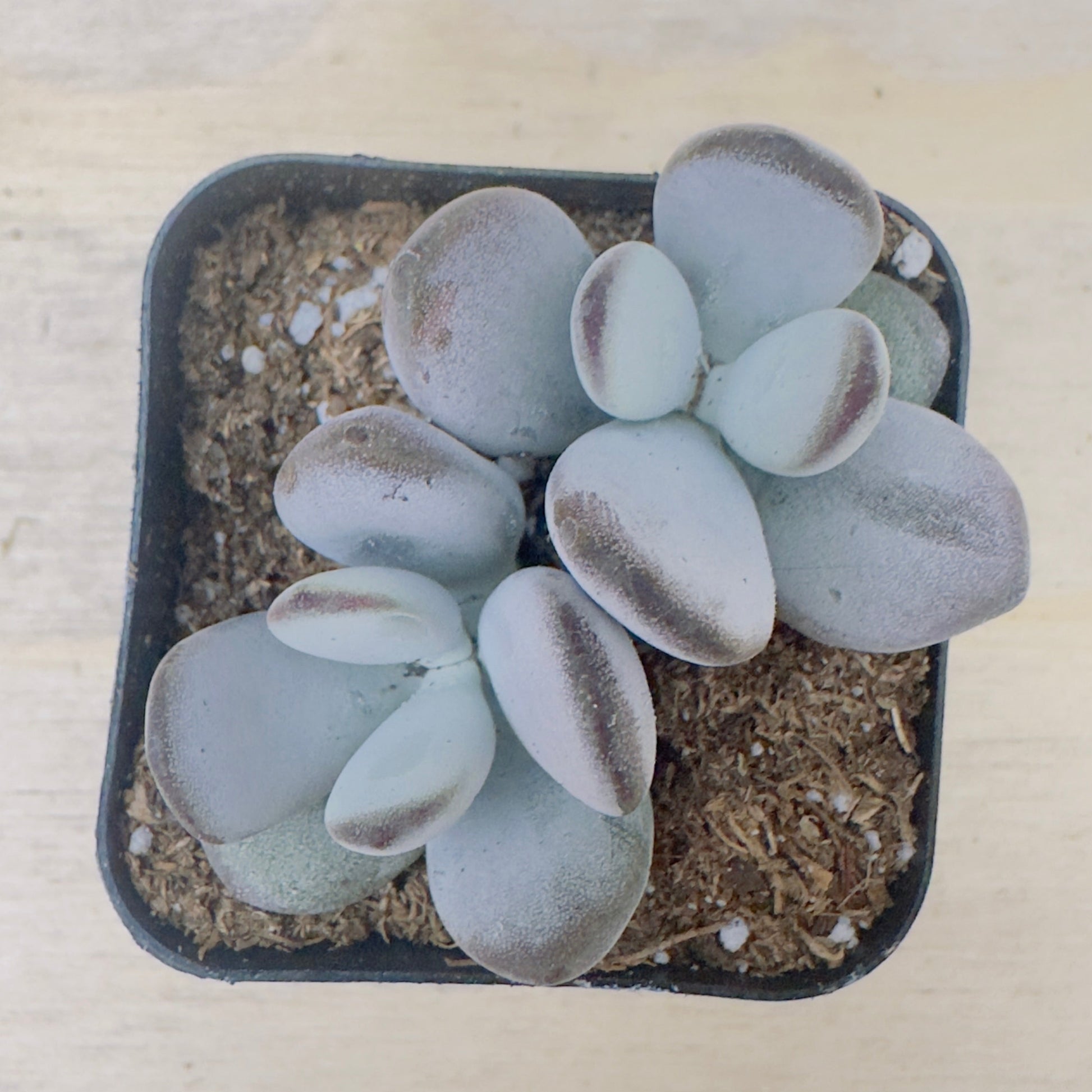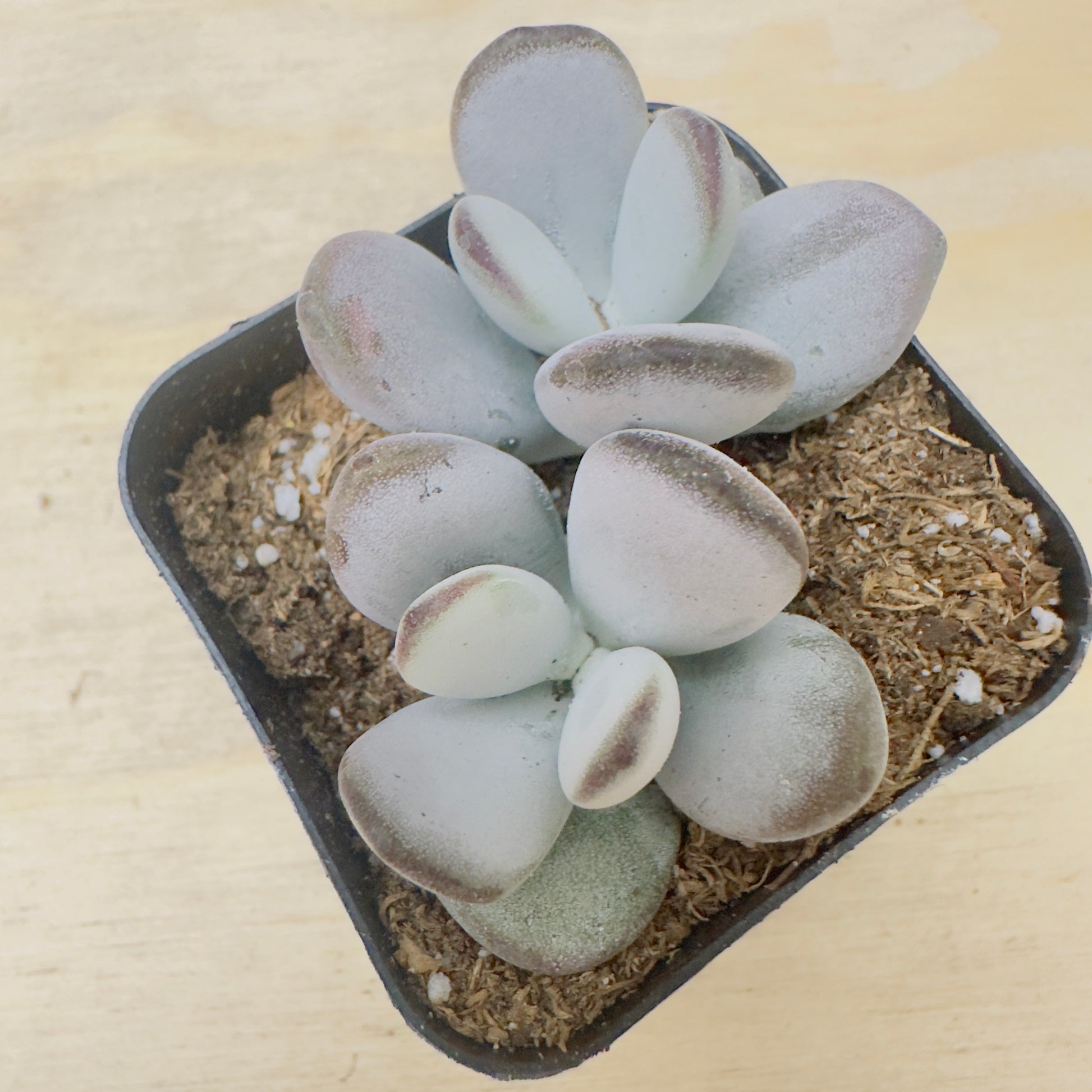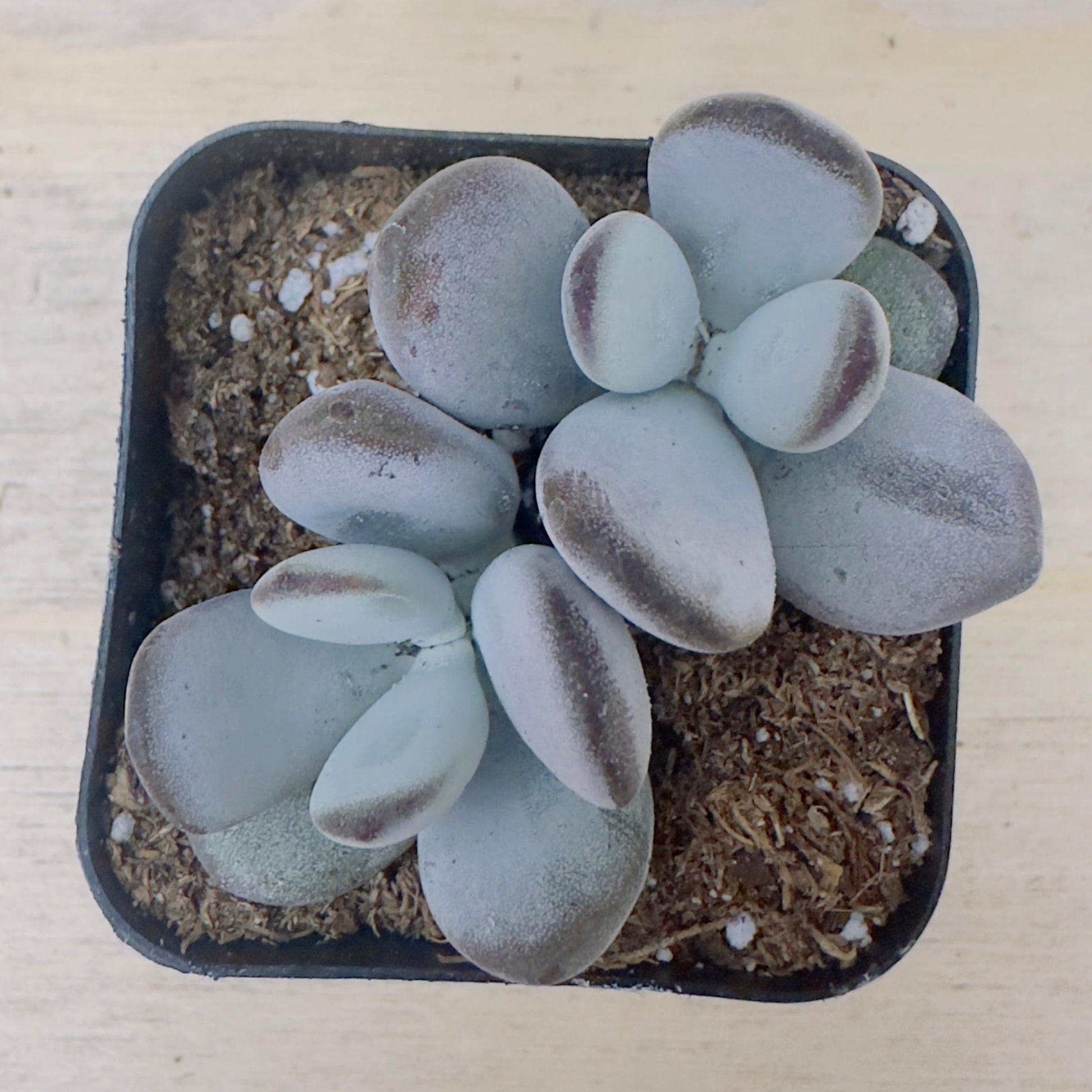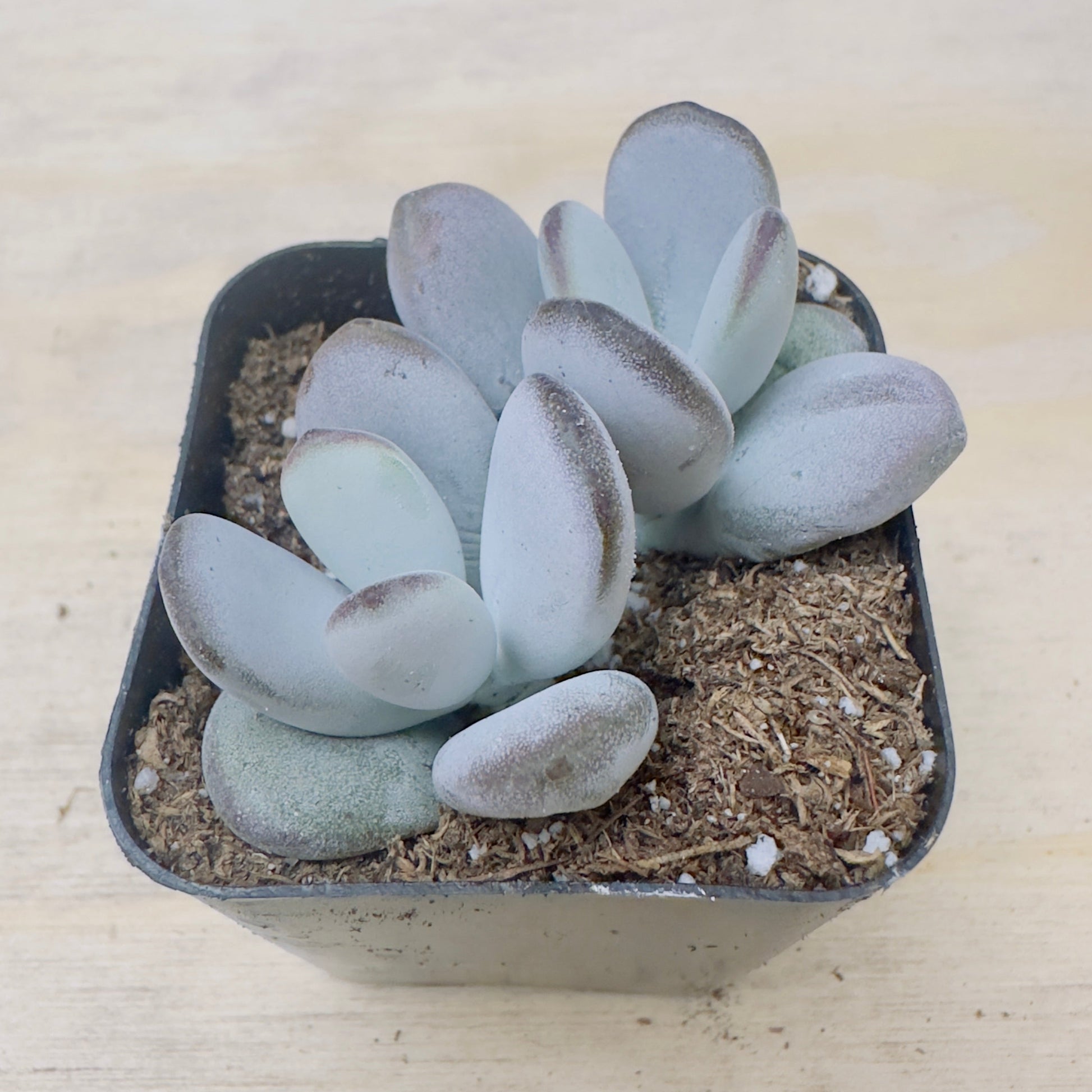Cotyledon orbiculata - Dinteri Jacobsen
Cotyledon orbiculata - Dinteri Jacobsen
In stock
Couldn't load pickup availability
📝 Description
Morphological Characteristics
Cotyledon orbiculata ‘Dinteri Jacobsen’ is a visually striking cultivar of Cotyledon orbiculata, belonging to the Crassulaceae family and native to South Africa. This variety is cherished for its powdery leaves and vibrant red margins, making it an excellent choice for both succulent collectors and landscape use.
The plant features thick, paddle- to spoon-shaped leaves coated with a layer of protective white farina (powder), giving it a silver-gray to bluish-green appearance. The leaf margins are typically adorned with deep red to purplish edges, which intensify under strong sunlight. Each leaf measures around 5–10 cm (2–4 inches) in length and grows in opposite pairs along upright stems.
The plant has a shrubby form and may reach 30–60 cm (1–2 feet) in height. In late summer to fall, mature plants can produce tall flower stalks bearing bell-shaped, coral to orange-red flowers, which are attractive to hummingbirds and pollinators.
Growth Habits
Cotyledon orbiculata ‘Dinteri Jacobsen’ grows upright and branching, forming a small to medium shrub over time. It is excellent for dry landscapes, large containers, rock gardens, or succulent borders. As it matures, stems may become woody at the base, and lower leaves naturally shed with age.
Maintenance Points
• Lighting: Prefers full sun to partial shade. Strong light enhances red margins and keeps the plant compact. Insufficient light can lead to green, stretched growth.
• Watering: Use the “soak and dry” method. Water deeply only when the soil is completely dry. Reduce watering in winter. Avoid overwatering to prevent root rot.
• Soil: Needs well-draining soil, such as a cactus/succulent mix. Add pumice, perlite, or coarse sand to improve aeration and drainage.
• Temperature: Thrives between 18–27°C (65–80°F). Tolerates light frost (down to around -2°C / 28°F) if kept dry, but should be protected from prolonged cold.
• Fertilization: Feed monthly in spring and summer using a diluted, low-nitrogen fertilizer. Do not fertilize during dormancy in winter.
• Potting: Use containers with good drainage. Repot every 2–3 years, ideally in spring, to refresh soil and encourage healthy growth.
• Humidity: Prefers dry air and good ventilation. Avoid misting or exposure to high humidity.
Reproduction Method
1. Leaf Cuttings (moderate success):
• Gently remove a full, healthy leaf and allow it to callus for 2–3 days in a shaded, dry location.
• Lay it on dry soil and mist lightly until roots and plantlets emerge.
2. Stem Cuttings (more common):
• Take a healthy stem 8–10 cm long, allow it to dry and callus, then insert into well-draining soil. Water sparingly until rooted.
3. Seeds:
• Can be propagated from seed, though this method is slower and less commonly used.
Additional Tips
• Pest Control: Susceptible to mealybugs, aphids, and spider mites. Inspect regularly and treat with neem oil or insecticidal soap as needed.
• Disease Prevention: Ensure excellent drainage and avoid water sitting in leaf crevices.
• Pruning: Remove dried lower leaves and spent flower stalks to maintain a tidy appearance. Prune leggy growth to encourage bushier form.
• Display: Pairs well with colorful or textural succulents like Aeoniums or Echeveria, and looks great in terracotta pots, rocky gardens, or minimalist arrangements.
• Safety Note: Toxic to pets and livestock if ingested. Keep out of reach of animals and children. Wear gloves when handling sap.
With its powdery leaves, bright red edges, and upright form, Cotyledon orbiculata ‘Dinteri Jacobsen’ is a stunning accent plant for dry gardens or succulent collections—ideal for warm climates and xeriscaping designs.
🌿 Care Tips
Plant Care
Light
Water
Soil
Temperature
Hardiness
Fertilizer
Propagation: Leaf/offset cuttings
Common issues: Etiolation, mealybugs, rot
🌟 Note: It’s normal for succulents to appear slightly shriveled after shipping. They usually recover within a few days in a suitable environment.
📦 Shipping Info
Seah Shipping Policy
Effective Date: November 2025
This Shipping Policy applies to orders delivered within the continental United States (the lower 48 states). By purchasing from Seah, you agree to the terms below.
1) Shipping Cost & Free Shipping
- Automatic rate calculation: Shipping is calculated at checkout based on weight, destination ZIP and carrier rates.
- Free Standard Shipping: Orders $59+ (pre-tax, after discounts) ship free to the lower 48 states.
- Alaska, Hawaii, Puerto Rico & other territories: Not eligible for free shipping or standard flat offers at this time.
- Taxes/Duties: Applicable sales tax and any fees are shown at checkout.
2) Processing Schedule
- Business days only: We process and ship Monday–Friday. No shipping on weekends or U.S. federal holidays.
- Handling time: 1–3 business days after payment confirmation.
- Cut-off time: Orders placed before 3:00 PM (PST) are prioritized for same-day processing; others roll to the next business day.
- Changes/Cancellations: Email support@seah.co within 12 hours of purchase; after that, the order may already be in processing.
3) Transit Times
| Method | Estimated Transit | Total ETA (Handling + Transit) |
|---|---|---|
| Standard | 5–8 business days | 6–11 business days |
| Express | 3–4 business days | 4–7 business days |
ETAs are estimates. Weather, holidays, carrier delays or high-volume periods may extend delivery times.
4) Seasonal Temperature & Plant Safety
- Winter (Nov–Mar): We strongly recommend adding a heat pack at checkout to protect plants from freezing. Orders shipped without a heat pack during cold conditions are not covered for cold damage.
- Summer heat: During extreme heat waves, we may hold shipments until temperatures normalize. We’ll notify you if there’s a hold.
- Packaging: Plants are carefully packed (bare-root or potted by type/size) to minimize transit stress.
5) Carriers & Tracking
- We ship via USPS / UPS / FedEx, selected automatically for best service to your address.
- When your order ships, you’ll receive a tracking email. Tracking typically activates within 24 hours.
- If you haven’t received tracking within 3 business days, contact us at support@seah.co or +1 (626)-999-1314.
6) Address Changes & Delivery Issues
- Before shipment: Request address changes within 12 hours of ordering.
- After shipment: We can’t modify the address once dispatched. Please contact the carrier for redirection options.
- PO Boxes: Supported for USPS only; UPS/FedEx require a street address.
- Seah isn’t responsible for delays or loss due to incorrect addresses provided at checkout.
7) Service Area
We currently ship to the continental U.S. (lower 48 states). Orders to AK/HI/PR and other territories are not eligible for free shipping and may be restricted.
8) Support
- Hours: Mon–Fri, 9:00 AM – 5:00 PM (PST)
- Phone: +1 (626)-999-1314
- Email: support@seah.co
- Address: 7870 Margaux Pl, Rancho Cucamonga, CA 91739, United States
Thank you for supporting our California nursery—each plant is hand-selected and packed with care. 🌱








